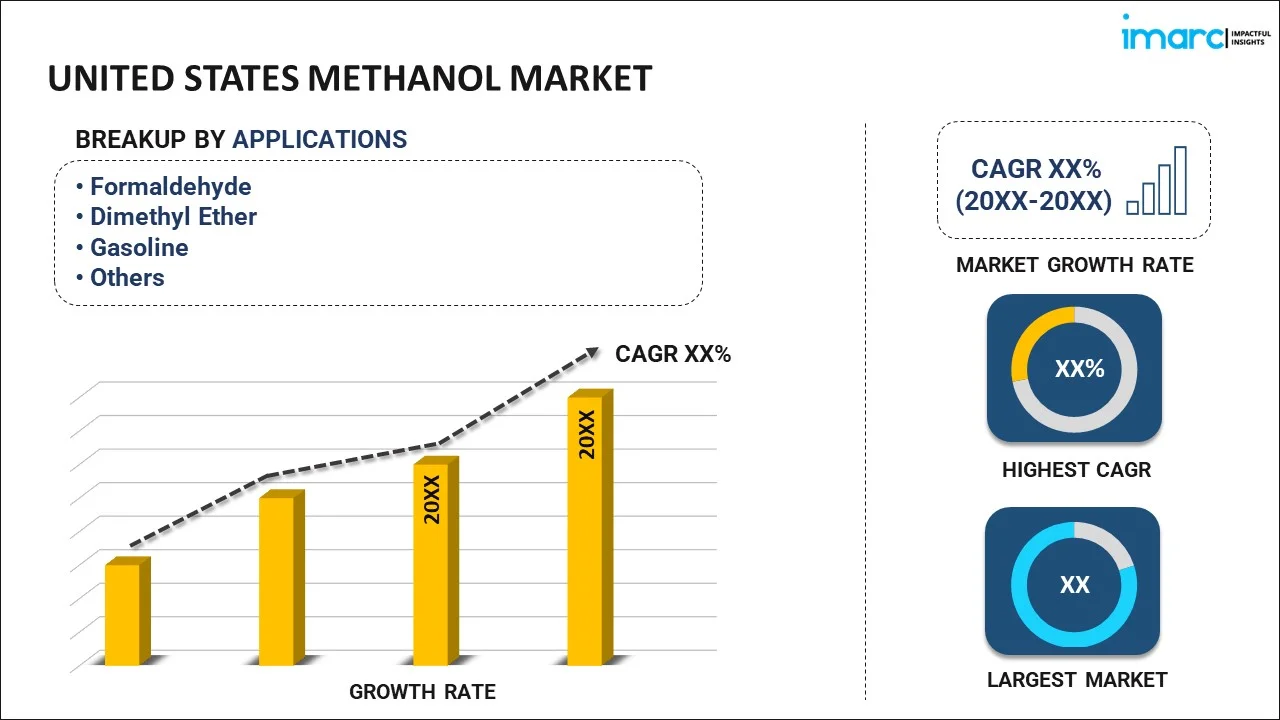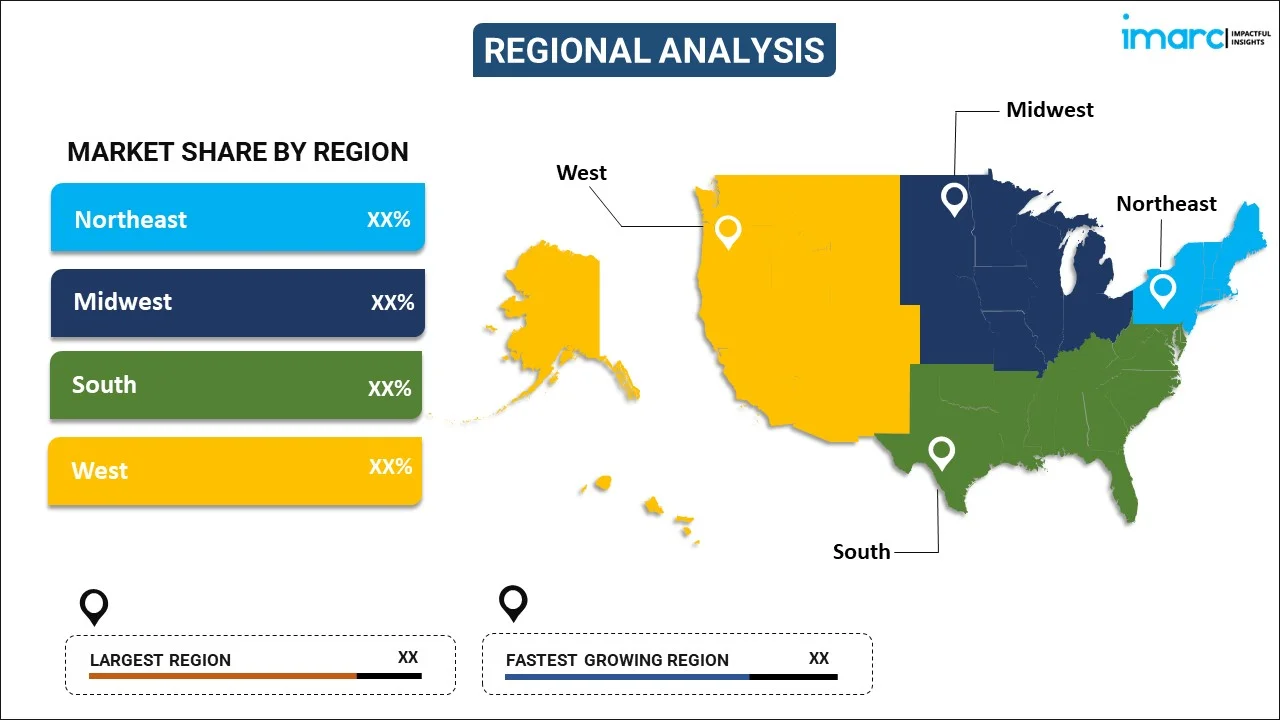
United States Methanol Market Report by Application (Formaldehyde, Dimethyl Ether, Gasoline, Chloromethane, MTBE/TAME, Acetic Acid, and Others), and Region 2025-2033
Market Overview:
The United States methanol market size reached USD 9.0 Billion in 2024. Looking forward, IMARC Group expects the market to reach USD 13.0 Billion by 2033, exhibiting a growth rate (CAGR) of 4.2% during 2025-2033. The increasing product demand in the chemical industry, the rising product adoption in fuel blending, the expanding applications in the energy sector, the development of renewable methanol production processes, and the growing demand for formaldehyde and resins are some of the factors propelling the market.
|
Report Attribute
|
Key Statistics
|
|---|---|
|
Base Year
|
2024 |
|
Forecast Years
|
2025-2033
|
|
Historical Years
|
2019-2024
|
| Market Size in 2024 | USD 9.0 Billion |
| Market Forecast in 2033 | USD 13.0 Billion |
| Market Growth Rate (2025-2033) | 4.2% |
Methanol, also known as wood alcohol, is a colorless, flammable liquid with the chemical formula CH₃OH. It is the simplest alcohol, consisting of one carbon atom bonded to three hydrogen atoms and a hydroxyl (OH) group. It is produced through various methods, including the destructive distillation of wood, but most commercially available methanol is synthesized from natural gas. Widely used in industrial applications, methanol is a versatile chemical with diverse uses. It serves as a crucial feedstock for the production of chemicals like formaldehyde, acetic acid, and various plastics. Additionally, methanol is employed in the synthesis of pharmaceuticals and agrochemicals and as a solvent in numerous processes. It holds significance in the energy sector as well. It is used as an alternative fuel and fuel additive, often blended with gasoline or utilized in fuel cells. Methanol's clean-burning properties make it an attractive option for reducing emissions in the transportation sector. The construction industry relies on methanol for the production of formaldehyde-based resins, which find applications in manufacturing plywood, laminates, and various engineered wood products. This underscores its importance in the fabrication of materials used in the construction and automotive sectors. Moreover, methanol has gained attention in the context of renewable energy. Processes such as biomass-to-methanol and carbon capture and utilization (CCU) are being explored to produce methanol from sustainable sources, aligning with efforts to reduce carbon footprints and promote greener energy solutions. As industries continue to evolve, methanol's role in various sectors, including chemicals, energy, and materials, underscores its significance in modern industrial processes.
United States Methanol Market Trends:
The market in the United States is primarily driven by the increasing demand for clean-burning fuels. In line with this, the rising demand in the chemical industry, where methanol is a crucial feedstock for the production of formaldehyde, acetic acid, and a range of chemicals, is positively influencing the market. The chemical sector's growth, driven by demand for polymers, resins, and other products, contributes to the overall expansion of the methanol market. Furthermore, its adoption in fuel blending is another driving force. As an alternative fuel or fuel additive, methanol is blended with gasoline, offering cleaner-burning properties and contributing to the reduction of greenhouse gas emissions in the transportation sector. Its application in fuel cells also adds to the demand for methanol as a promising energy carrier. Besides, the expanding applications in the energy sector further fuel market growth. Methanol is utilized as a fuel in power generation, providing an efficient and cleaner-burning option. The potential use of methanol in the production of green energy aligns with global efforts to transition towards more sustainable and environmentally friendly energy sources. Moreover, the emerging trends in renewable methanol production are shaping the market. Processes like biomass-to-methanol and carbon capture and utilization (CCU) are gaining traction, contributing to the development of sustainable methanol production methods. This aligns with the growing emphasis on environmental sustainability and reducing the carbon footprint associated with traditional methanol production. Additionally, the growing demand for formaldehyde and resins in the construction and automotive industries is a significant factor fueling the market growth. Methanol is a key component in the synthesis of formaldehyde-based resins used in manufacturing various engineered wood products, laminates, and construction materials. As industries continue to prioritize sustainability and cleaner energy solutions, the methanol market is poised for sustained expansion across diverse industrial sectors.
United States Methanol Market Segmentation:
IMARC Group provides an analysis of the key trends in each segment of the market, along with forecasts at the country level for 2025-2033. Our report has categorized the market based on application.
Application Insights:

- Formaldehyde
- Dimethyl Ether
- Gasoline
- Chloromethane
- MTBE/TAME
- Acetic Acid
- Others
The report has provided a detailed breakup and analysis of the market based on the application. This includes formaldehyde, dimethyl ether, gasoline, chloromethane, MTBE/TAME, acetic acid, and others.
Regional Insights:

- Northeast
- Midwest
- South
- West
The report has also provided a comprehensive analysis of all the major regional markets, which include the Northeast, Midwest, South, and West.
Competitive Landscape:
The market research report has also provided a comprehensive analysis of the competitive landscape in the market. Competitive analysis such as market structure, key player positioning, top winning strategies, competitive dashboard, and company evaluation quadrant has been covered in the report. Also, detailed profiles of all major companies have been provided.
United States Methanol Market Report Coverage:
| Report Features | Details |
|---|---|
| Base Year of the Analysis | 2024 |
| Historical Period | 2019-2024 |
| Forecast Period | 2025-2033 |
| Units | Billion USD |
| Scope of the Report | Exploration of Historical and Forecast Trends, Industry Catalysts and Challenges, Segment-Wise Historical and Predictive Market Assessment:
|
| Applications Covered | Formaldehyde, Dimethyl Ether, Gasoline, Chloromethane, MTBE/TAME, Acetic Acid, Others |
| Regions Covered | Northeast, Midwest, South, West |
| Customization Scope | 10% Free Customization |
| Post-Sale Analyst Support | 10-12 Weeks |
| Delivery Format | PDF and Excel through Email (We can also provide the editable version of the report in PPT/Word format on special request) |
Key Questions Answered in This Report:
- How has the United States methanol market performed so far and how will it perform in the coming years?
- What has been the impact of COVID-19 on the United States methanol market?
- What is the breakup of the United States methanol market on the basis of application?
- What are the various stages in the value chain of the United States methanol market?
- What are the key driving factors and challenges in the United States methanol?
- What is the structure of the United States methanol market and who are the key players?
- What is the degree of competition in the United States methanol market?
Key Benefits for Stakeholders:
- IMARC’s industry report offers a comprehensive quantitative analysis of various market segments, historical and current market trends, market forecasts, and dynamics of the United States methanol market from 2019-2033.
- The research report provides the latest information on the market drivers, challenges, and opportunities in the United States methanol market.
- Porter's five forces analysis assist stakeholders in assessing the impact of new entrants, competitive rivalry, supplier power, buyer power, and the threat of substitution. It helps stakeholders to analyze the level of competition within the United States methanol industry and its attractiveness.
- A competitive landscape allows stakeholders to understand their competitive environment and provides an insight into the current positions of key players in the market.
Need more help?
- Speak to our experienced analysts for insights on the current market scenarios.
- Include additional segments and countries to customize the report as per your requirement.
- Gain an unparalleled competitive advantage in your domain by understanding how to utilize the report and positively impacting your operations and revenue.
- For further assistance, please connect with our analysts.
 Request Customization
Request Customization
 Speak to an Analyst
Speak to an Analyst
 Request Brochure
Request Brochure
 Inquire Before Buying
Inquire Before Buying




.webp)




.webp)












